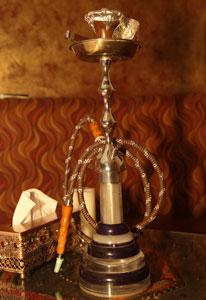Hookah smoking poses health risks, NIH studies show
March / April 2014 | Volume 13, Issue 2
By Cathy Kristiansen
Puffing tobacco through waterpipes, a Middle Eastern tradition, is exploding in global popularity, including among American college students. Many assume these gadgets, also known as hookahs, provide a safer, cleaner way of using tobacco. Yet NIH-funded researchers have determined the smoke from these pipes contains an array of harmful chemicals, including ten times more carbon monoxide than the smoke from a single cigarette. Hookah smokers take an average of about 100 puffs per session, with each one delivering approximately the same amount of smoke typically consumed from a single cigarette, studies show.

Photo by Cathy Kristiansen
NIH-funded researchers have shown waterpipe smoking,
popular among U.S. college students, carries serious
health risks.
"Now hookahs are the number two way of using tobacco on campus, it's becoming a craze," said Fogarty grantee Dr. Wasim Maziak of both the Syrian Center for Tobacco Studies and Florida International University. He added, "We have been beating the drums about the dangers of hookah smoking - including nicotine addiction, and the risk of cancer and cardiovascular disease - but the spread of waterpipe use continues unabated. This calls for a more comprehensive approach involving policy and regulatory oversight."
There is little or no regulation of hookahs and many factors attract new people to waterpipes, including the misperception that the water in the bowl cleanses away the toxicants. Smokers are also drawn by novelty flavors, such as melon and mint-rose, and to the communal aspects of smoking a waterpipe in a cafe.
Yet, smoke from both the tobacco and the charcoal used to heat it produce a toxic soup at least as dangerous to health as cigarettes, researchers report. Studies have compared the smoke from each form and found many similar harmful compounds, although in varying quantities. Waterpipes, for instance, produce not only much more carbon dioxide, but also three to five times the amount of volatile aldehydes, such as formaldehyde, which are linked to a variety of disorders including pulmonary disease. Waterpipe smoke also contains triple the level of phenols - compounds thought to promote DNA mutations and cardiovascular disease - and high concentrations of benzene, a leukemia trigger.

Photo by Cathy Kristiansen
Smoke from waterpipes contains an
array of harmful chemicals.
Both waterpipes and cigarettes expose the smoker to ultrafine particles, which are not easily removed from the body or environment, polyaromatic hydrocarbons that are contained in "tar" that is present in the smoke, and enough nicotine to cause dependence. In sum, both users and bystanders breathe in compounds that cause lung inflammation, oxidative stress, higher counts of immune cells and other precursors to cancers, chronic obstructive pulmonary disease and cardiac dysfunction.
Even herbal waterpipe smoking doesn't receive a clean bill of health, as these herbal products contain and deliver all of the same toxicants found in tobacco smoke except of course for nicotine.
Researchers funded by Fogarty's
International Tobacco and Health Research and Capacity Building Program were among the first to sound the alarm about waterpipes a decade ago. There are signs policymakers are starting to pay attention. "I'm getting calls right and left from regulators wanting to know more," Maziak said. Ideally, he added, all U.S. regulations for cigarettes would be extended to cover waterpipes as well. Currently, the U.S. has about 2,000 smoke-free laws, but very few include waterpipes.
"Flavors in tobacco are doing a lot to spread this lethal form of tobacco use," said NIH grantee Dr. Thomas Eissenberg of Virginia Commonwealth University (VCU). "People say, 'There's no warning label on the packet so it must be safe.' We need the same kind of restrictions worldwide that are presently getting in place for cigarette smoking."
In addition to Fogarty, several other NIH components support waterpipe research, including the National Cancer Institute (NCI); National Heart, Lung and Blood Institute (NHLBI); National Institute of Nursing Research (NINR); National Institute of Dental and Craniofacial Research (NIDCR); National Institute on Alcohol Abuse and Alcoholism (NIAAA), National Institute of Arthritis and Musculoskeletal and Skin Diseases (NIAMS), National Institute of Child Health and Human Development (NICHD), and National Institute on Drug Abuse (NIDA). Since the mid-2000s, NIH-funded researchers have produced more than 100 articles in peer-reviewed journals.
Regulators can use this evidence to justify waterpipe controls and unwitting smokers should listen to the facts about their habit, Eissenberg said, concluding, "We need to get the word out to waterpipe smokers themselves that they are exposed to many of the same toxins that are in cigarette smoke."
More Information
To view Adobe PDF files,
download current, free accessible plug-ins from Adobe's website.